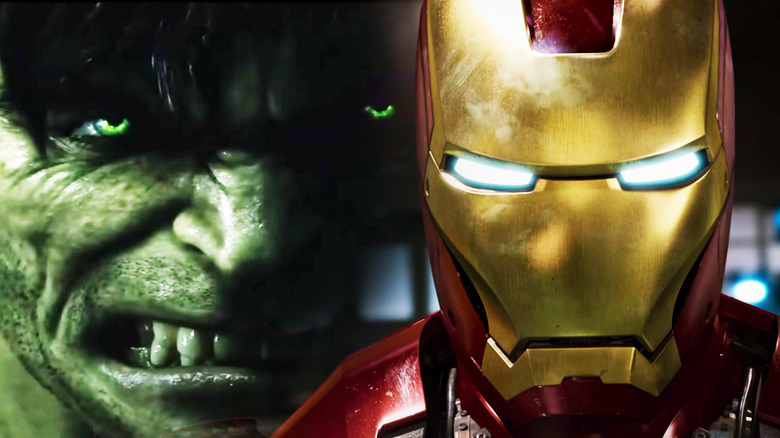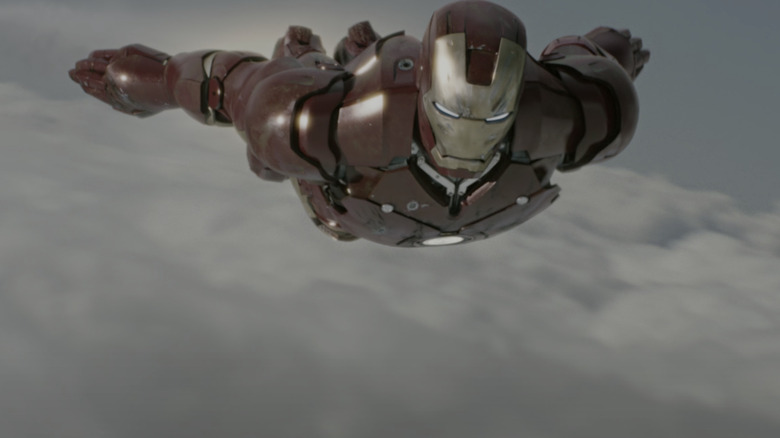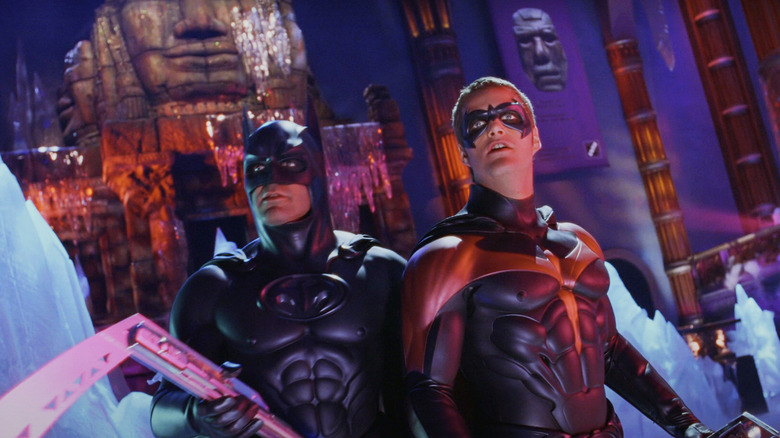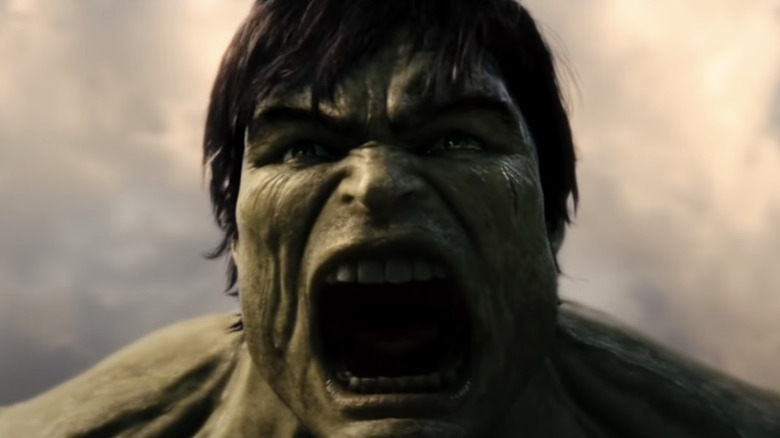How A Group Of Children Determined The First Movies In The MCU
Well, "The Marvels" might have been a box office dud, signaling a historic low point for the Marvel Cinematic Universe, but the franchise will always remain one of the biggest Hollywood success stories of all time. By now, we all know how Kevin Feige and his cohorts took under-appreciated Marvel characters and created a run of obscenely popular blockbusters that dominated the box office for the better part of a decade. But there was a lot more involved than simply whacking Robert Downey Jr. in an Iron Man suit and raking in the dough.
2008's "Iron Man" was, of course, where it all started, with the Jon Favreau-directed film proving a massive hit and changing Hollywood forever. But even getting to the point where they could start producing an Iron Man movie proved to be a journey of its own for Marvel. In 2005 the Wall Street Journal reported that the company had secured a "$525 million, seven-year debt facility to finance 10 films based on its comic-book characters," courtesy of the fine folks over at Merrill Lynch. The idea was for Marvel to finance its own movies to increase their own profits, gain greater creative control, and generally just have more oversight of the movie-making process. Prior to that, Marvel had licensed numerous characters to other studios, most famously handing the movie rights for Spider-Man over to Sony and X-Men to Fox. With this half-a-billion loan, however, the company was free to finance its own films based on the remaining characters.
Those characters included Captain America, Hulk, Thor, and of course Iron Man himself, alongside a range of other even lesser-known heroes. So how did the Marvel suits decide to let the tin man out the gate first? Well, apparently it was all down to some kids.
One home run
As recounted in Joanna Robinson, Dave Gonzales, and Gavin Edwards' book "MCU: The Reign of Marvel Studios," then CEO of Marvel Comics and Marvel Entertainment, Ike Perlmutter, was keeping a close eye on the newly-formed Marvel Studios following the Merrill Lynch deal. Prior to "Iron Man" debuting, the studio was overseen by Avi Arad, alongside David Maisel as Vice Chairman, and future Marvel Studios head Kevin Feige serving as Executive Vice President. All of them were under pressure to, as the books' authors write, produce "at least one home run to stay in the game."
Evidently, the main heroes in consideration to launch the MCU were Iron Man, the Incredible Hulk, and Ant-Man. Back in the early 2000s, however, none of these characters had anywhere near the kind of cultural caché or widespread recognition of Superman or Batman. According to Robinson, Gonzales, and Edwards, Marvel's consumer testing had actually shown that almost no one knew who Iron Man was. So why was Tony Stark chosen to lead the very first MCU movie? As the authors wrote:
"The Marvel executives had reason to believe the character was a strong choice for a movie: they knew Iron Man made for a good toy. In 2005, Marvel ran a focus group for children. The person leading the focus group described Marvel characters to the kids—origin, personality, powers—and at the end of the presentation, asked which hero they would most want to play with as a toy. John Turitzin remembered, 'After describing Iron Man, he jumped from the eighth most popular character to being the first character. Kids thought it was really cool to have, basically, a robot that could fly and could shoot beams out of the palms of his hands. They thought that was great.'"
Make it more Toyetic
Anyone who's seen Netflix's "The Toys That Made Us" will have heard the term "Toyetic." It basically refers to how well an IP lends itself to merchandise, specifically toys. The concept is a constant consideration particularly when it comes to superhero movies because ever since Warner Bros. redefined blockbuster marketing with the box office smash that was "Batman" 1989, selling toys off the back of a successful superhero movie has been huge business. The "Toyetic" nature of Batman as a media property became the bane of Chris O'Donnell's life when playing Robin in 1997's "Batman & Robin," with the actor saying he felt like he was "making a toy commercial" while shooting the ill-fated Batman installment. Director Joel Schumacher even confirmed in a 2000 Guardian interview that during pre-production he was being pressured by Warner Bros. and the companies that had signed on for merchandising to "make the film more 'toyetic'."
Obviously, in the case of the much-maligned "Batman & Robin," too much focus on selling toys resulted in a historic blunder of a film. But studios didn't let that stop them from trying to sell toys off the back of their films. "Iron Man" is a perfect example of how merchandizing figures into production before a movie has even started pre-production and doesn't necessarily hinder the result. Ultimately, it's not like "Iron Man" was a bad film, with Jon Favreau having ample creative freedom to make the movie the more character-focused project he had envisioned — even pulling some sneaky behind-the-scenes maneuvers to cast his ideal star, Robert Downey Jr., in the lead.
Thanks, kids
"Iron Man" made $585 million on its $186 million budget, making for the "home run" Marvel needed. It was followed by "The Incredible Hulk" later in 2008 — a decision that was once again based on the character's historical popularity in the toy and merchandise market. That film brought in $265 million on a $137 million budget. Not quite as big a success but a success nonetheless. Of course, Marvel would go on to dominate the movie landscape, with Iron Man proving to be arguably the most popular hero in the MCU.
But as it turns out, pretty much every hero Marvel still held the film rights to back in 2008 was toyetic. According to the WSJ, the original Merrill Lynch deal involved using film rights as collateral on the half-a-billion-dollar loan. Those rights pertained to Captain America, The Avengers, Nick Fury, Black Panther, Ant-Man, Cloak & Dagger, Dr. Strange, Hawkeye, Power Pack, and Shang-Chi. All of which we now know based on the cavalcade of action figures and accessories that have lined the shelves of Target and alike over the last fifteen years, are extremely "toyetic."
That said, Iron Man and Hulk seem to have something inherently action-figurey about them, with the former's sleek armor and the latter's bulky frame just straight up making for cool-looking toys. Aside from far too many movies and general superhero fatigue setting in, then, maybe that's been the issue with MCU films of late — the heroes just aren't toyetic enough? Whatever the case, 2024 will prove crucial for the MCU, as Kevin Feige and co. scramble to right the (many) wrongs of recent years.



